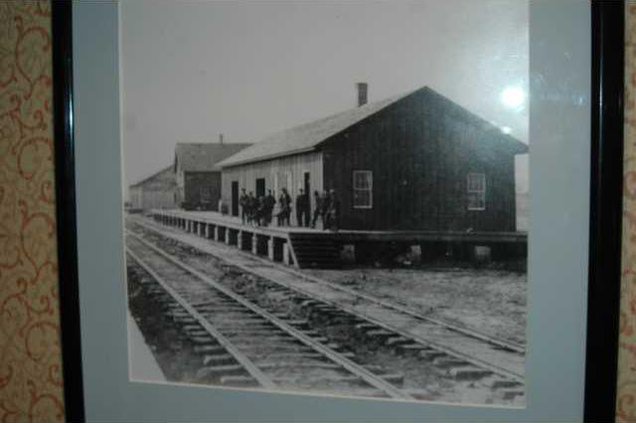Editor’s Note: Local historian David Clapsaddle writes about aspects on the Santa Fe Trail. This series profiles how Santa Fe Trail freight, passengers and mail shifted from the overland trail to railways.
By DAVID K. CLAPSADDLE
Although Gen. Winfield Scott Hancock, commander of the Department of the Missouri, referred to a road for emigrants, the route he suggested was first used by a stage company. Upon removal of the railhead from Fort Harker to Hays City, Barlow, Sanderson and Company was ordered by the U.S. Postal Department to initiate mail deliveries from Hays City to Santa Fe, N.M, effective Nov. 1, 1867.
Beginning at Hays City, the stageline ran to Fort Dodge and continued over the mountain branch of the Santa Fe Trail to Santa Fe. Stages departed from each end of the line on Monday, Wednesday and Friday, the one way trip being completed in 4 1/2 days.
Early in 1868, the route experienced a steady stream of military traffic, with freight deliveries being made on a regular basis.
John Murphy, a teamster recalled:
“In the summer of 1868, I was assigned to the post train at Fort Hays. This train was organized and equipped at Fort Harker and proceeded to Fort Hays … we were kept constantly on the road between Fort Hays and Fort Dodge. As the distance between the two posts was nearly 100 miles, it required about three days to make the trip each way. We were allowed no rest at the Fort Hays end of the trip.”
Thus was born the Fort Hays-Fort Dodge Road.
During the fall of 1868, traffic on the road dramatically increased in preparation for General Sheridan’s winter campaign against the southern plains tribes.
Lt. Col. George Armstrong Custer, still under suspension from court-martial action, was summoned by Sheridan to lead the 7th U.S. Cavalry in this campaign.
Arriving at Fort Hays from his Michigan home on Oct. 30, Custer hurried down the road two days later to reassume command of his old regiment.
Following Custer down the road were supplies for the campaign including 4,000 rations to be transported ninety miles beyond Fort Dodge to Camp Supply in Indian Territory. Six hundred unbroken mules from Kentucky and Missouri where shipped by rail to Hays and subsequently hitched, “kicking, squealing, and bucking,” to 100 wagons. Driving four abreast, three-span of mules per wagon, the wagons stretched out for a full mile.
Eighteen-year-old Billy Dixon, a teamster on the expedition, recalled:
“The first day out we got to Smoky Hill River and camped for the night. We then pulled to Walnut Creek, and the third day brought us to Pawnee Fork. Between this place and what is now the town of Bucklin. We had a stampede that for real excitement beat anything I had ever seen. The mules ran in every possible direction, overturning wagons, and outfit colliding with outfit until it looked as if there would never be a pound of freight delivered at Supply. Many of the wagons were so badly demolished that they had to be abandoned and left behind. Their loads were piled on other wagons and carried forward.
“Our route carried us past Saw Log Creek, Fort Dodge—there was no Dodge City at that time—Mulberry Creek, and thence to Bluff Creek.
“We reached Camp Supply at the end of a 12-day journey. The supplies were unloaded on the ground and covered with tarpaulins.”
Upon return to Fort Hays, a second such trip was conducted.
To augment the regular troops in this campaign, General Sheridan called upon the governor of Kansas, Samuel Crawford, to raise a volunteer regiment of cavalry.
Crawford recruited 1,200 volunteers and resigned his office to assume the command of the newly formed 12-company regiment designated as the 19th Kansas Cavalry.
On Nov. 5, ten companies of the regiment marched from Topeka, to join the regulars in Indian Territory. Subsequently, the two remaining companies, D and G, traveled by rail to Hays City, marched down the road to Fort Dodge, and continued south to join the rest of the regiment.
On Nov. 15, General Sheridan departed Fort Hays for Fort Dodge.
Caught in a blizzard the first night out, the general “took refuge under a wagon, and there spent a miserable night.”
Continuing down the road the following day, Sheridan reached Fort Dodge that evening in spite of persistent sleet and snow. Proceeding on from Fort Dodge, Sheridan set up headquarters at newly established Camp Supply constructed under the supervision of Lt. Col. Alfred Sully who had assumed command of the expedition.
Seeking a more aggressive leader, Sheridan relieved Sully, placing Custer in command.
With the full force of Sheridan’s confidence in his favor, Custer marched south on Nov. 23 to confront the enemy. Four days later, the Seventh Cavalry struck Black Kettle’s Cheyenne village on the Washita. Fifty-three captives, all women and children, were taken.
From the Washita, Custer marched triumphantly to Camp Supply where he deposited the prisoners and returned south in pursuit of other victories.
Meanwhile, the captives were marched on to Fort Dodge and up the road to Fort Hays where they were imprisoned in a pen-like structure. In 1869, Custer marched to Fort Dodge and up the road with his own regiment, the 19th Kansas Cavalry which had been put under Custer’s command, and two women (Sarah White and Anna Brewster Morgan) who had been rescued from Cheyenne Indians holding them captive.
Accompanying the march were three Cheyenne warriors whom Custer had taken hostage to guarantee the safe return of the women. On June 13, 1869, some seven months after the Battle of Washita, the Cheyennes were marched back down the road and returned to their families in Indian Territory.
(To Be Continued)
Lt. Col. George A. Custer leads 7th Cavalry
Trails to Rails Part 5




